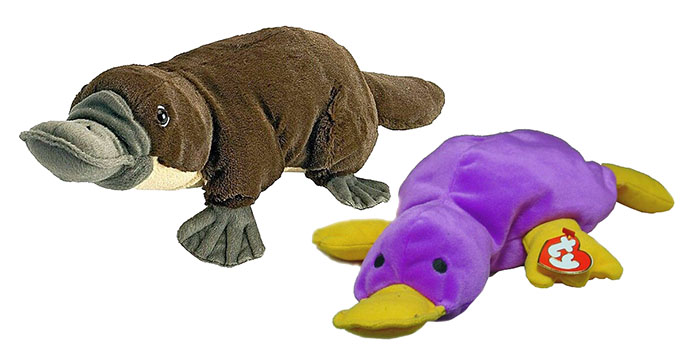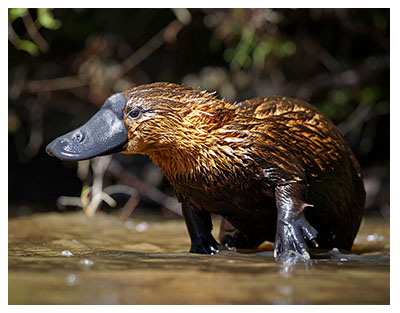

The Unusual Platypus
Find platypus Australian mammals in the Outback at Animals N More.
Hi. My name is Patti and I'm a Ty Beanie Baby Platypus. I'm the purple guy at right. I come from Australia and Tasmania. Sometimes I'm called a duck-billed platypus because of my muzzle that looks alot like a duck's bill. But I'm not a bird at all. I'm a mammal. However, like a bird I do lay eggs. Pretty cool, huh! I like to eat bugs, worms, small crustaceans and mollusks. At top left is a Wild Republic Cuddlekins Platypus and below him is Allie the Platypus from Douglas. You can find these at our sponsor's online gift shop: www.jeanniescottage.com. The link above will take you there.
The Duckbill platypus, (Ornithorhynchus anatinus),is a strange egg-laying mammal. The platypus has a bird's beak, or a duck's bill, which is used for nuzzling in the mud and slush when foraging for worms, aquatic grubs, and other favorite foods. But the bill, instead of being hard and horney, is soft and leathery and is charged with sensitive nerves.
The platypus is expert as swimming and diving. Its body is admirably adapted for these activities. Its grayish-brown fur is as thick and close as that of an otter, and the tail is flattened like that of a beaver, but well furred. The animal has broadly webbed feet, the front ones furnishing the driving power in the water.
The duckbill breeds once a year. It is during spring that breeding occurs. The animals mate in the water. After 12 to 14 days, anywhere from1 to 3 eggs are laid in a den created by the female. In preparation for her young, the female digs a den laboriously, in the bank of a stream. It is a spacious chamber with a tunnel entrance under water, and also has an air shaft, or ventilator. When the chamber is finished, she lines it with leaves from the gum tree, and shredded grass. She allows no males into her den as she waits for the eggs to arrive.
Finally they come, about 15 days after mating time. There are generally two of them - one more or less is possible - in a clutch (the name used for the normal number of eggs in a bird's nest). They are soft-shelled and about the size of a pigeon's egg, but rounder. Perhaps to avoid any chance of their being lost in the spacious leafy nest, the two eggs are firmly sealed together side by side. If there are three, they are sealed in a triangle.
Like a bird, the new mother is broody during incubation. For this period of lethargy she locks herself in her underground den by plugging up the entrance with six or eight inches of earth. She does not sit on the eggs like a bird or carry them in a pouch like the echidna, but clutches them to her breast and rolls up into a ball. It takes nine to ten days to complete the incubation.
At first the young platypuses are naked, blind and helpless, with queer little beaks. The mother platypus, like the mother spiny anteater, feeds them on milk secreted in her teatless mammary glands. During these early weeks, the development of the babies is remarkably slow. When two months old, they are covered with short fine fur but must still depend on their mother for body heat, and their eyes have not yet opened. It is all of four months before the youngsters see the light of day. They are amiable little creatures, and play like puppies.
Even at mating time, the male and the female show little or no affection for each other. But they do like company. After breeding season is over, the platypuses dwell together in a burrow with general living quarters for both sexes.
The male has a horny, hollow spur on his hind foot, which is connected to a poison gland. This is the male platypuses only means of defense. It can inflict a very painful wound.
Platypus produce many vocalizations, which include a growling sound when disturbed.
Platypus forage for food for about 12-13 hours every day and can consume up to half their own body weight a day. They dive for between 20-40 seconds during foraging, resting on the surface for only 10 seconds between dives. They perform about 80 dives per hour.
Platypus forage on the bottom, using their electro-sensitive bill to find food. Their prey includes worms, insects, crustaceans, mollusks and small vertebrates. Typical prey includes caddisfly larvae, mayflies, two-winged flies and shrimps. The prey is carried in cheek-pouches to the surface where it is eaten. Rather than teeth, platypus have small, horny pads that they use to crush their prey.




